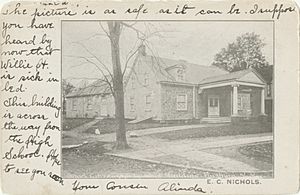Queens Memory Project facts for kids
The Queens Memory Project is a special program that collects and saves the history of Queens, a big part of New York City. It's like building a giant scrapbook or a digital time capsule for the borough! This project is a team effort between Queens College, City University of New York and Queens Public Library.
The Queens Memory Project gathers oral history interviews and photographs from people who live in Queens. These personal stories and pictures are then put together with old historical photos, maps, and news articles. The main goal is to create a huge online collection where everyone can explore the memories and history of Queens in one easy-to-find place.
Contents
How the Project Started
The Queens Memory Project began in June 2010. A student named Natalie Milbrodt started it as a special project. She worked at Queens College Libraries. At first, she focused on the Flushing neighborhood. She interviewed 20 people who lived there.
Later, the project got money from a group called METRO. This helped Natalie team up with the Queens Public Library. They combined their old historical items about Queens. The project's website was launched on October 27, 2011. Since then, the Queens Memory Project has grown. It now collects stories from all over Queens. They also work with teachers, artists, and community groups. Soon, people will even be able to add their own stories directly to the website!
Learn to Record History
The Queens Memory team offers free training sessions. These are for anyone who wants to learn how to conduct oral history interviews. These trainings help people in Queens learn how to create great additions to the local history collections. You can find out more about these weekly trainings on their website.
Real Stories from Queens Residents
The project has collected over 500 oral history interviews. An oral history is when someone records a conversation with a person about their life and experiences. Most of these interviews were done by volunteers. These volunteers learned how to do interviews from the Queens Memory Project staff. Many of these interviews are available to listen to online, and some even have written versions.
Listen to Queens Stories
Since 2019, the Queens Memory Project has also made a podcast. This podcast often features the voices of people from Queens. The first season talked about immigrants in Queens. The second season was about life in Queens during the COVID-19 pandemic. This season even won an award! The third season is called "Our Major Minor Voices." It has episodes in two languages and shares the real stories of Asian Americans in Queens.
Sounds of Queens
The project also collects "Wild Sound recordings." These are audio recordings that capture the sounds of events and public places in Queens. It's like listening to the everyday sounds of the borough!
Pictures of Queens Life
Many digital photographs have been given to the project by people living in Queens. These pictures show different parts of life in Queens. They are all part of the project's growing collection.
Old Papers and Maps
Other items in the Queens Memory Project include digitized maps and old news clippings. They also have other "ephemera." This word means items that were only meant to be used for a short time, like old tickets or flyers. But now, they help us understand the past!



